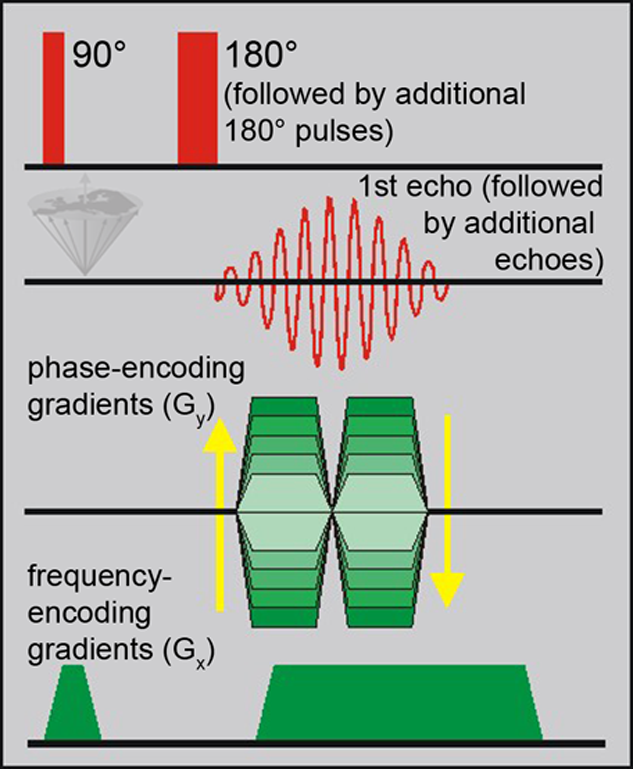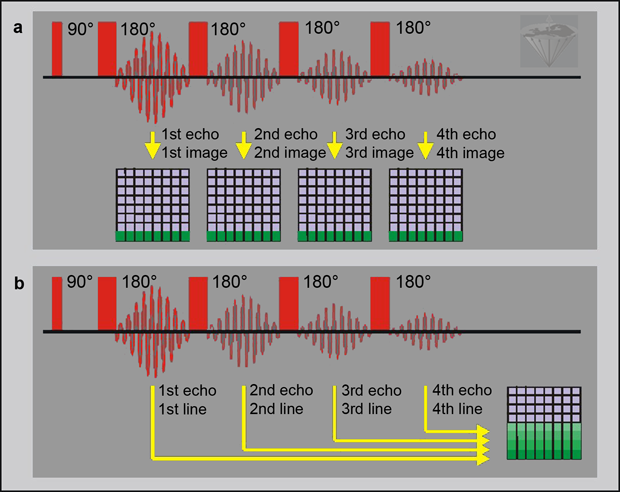





 he RARE sequence (Rapid Acquisition with Relaxation Enhancement; also called Rapid Spin Echo, RSE; Fast Spin Echo, FSE; or Turbo Spin Echo, TSE) was introduced by Jürgen Hennig in 1986 [⇒ Hennig 1986]. It is based on the multiple echo sequence.
he RARE sequence (Rapid Acquisition with Relaxation Enhancement; also called Rapid Spin Echo, RSE; Fast Spin Echo, FSE; or Turbo Spin Echo, TSE) was introduced by Jürgen Hennig in 1986 [⇒ Hennig 1986]. It is based on the multiple echo sequence.
Over the years, RARE has mostly replaced the conventional multiple spin-echo pulse sequence, which was the most common sequence used in clinical imaging. Blurring in fine detail, however, will hinder a complete replacement. The classical spin-echo sequence remains the most solid, reliable, and reproducible pulse sequence in MR imaging.
Rather than using the same amount of phase-encoding for each echo and each echo as one line for an image associated with a particular TE, in RARE sequences different amounts of phase-encoding can be applied to each echo. This enables them to be used as different lines in a single image (Figures 08-03 and 08-04).

Figure 08-03:
The RARE pulse sequence. A train of echoes is created and each echo is individually phase-encoded. Usually eight to sixteen echoes are used. There are several different variations with different styles of gradient switching.

Figure 08-04:
A comparison of (a) a multiple spin-echo and (b) a RARE sequence.
Every echo in the SE sequence is used to create an individual image (one echo = one line per image), whereas in a RARE sequence several echoes contribute lines to a single image of the raw data matrix (k-space), as in this example, or to two images.
For example, a multiple echo sequence with 8 echoes, implemented as a RARE sequence can contribute 8 phase-encoding lines to a single image, or 4 phase-encoding lines to two images. This results in reductions of 8 or 4, respectively, in the number of excitations required to collect the full data set, while retaining most of the clinically useful contrast of the spin-echo sequence.
Considering a RARE sequence in which 8 echoes are used to provide 8 lines for a 128×128 image, each line has a different echo time and hence T2 weighting. This is an undesirable constraint of the RARE sequence, but it can be overcome by altering the assignation of the particular echoes to respective lines in k-space. The probably most effective version of the RARE sequence uses the first half of the echo train to provide the lines for a ρ-image and the second half for a T2-weighted image.
In this way, one retains the clinically useful double-echo sequence, while reducing the scan time by a factor of between 2 and 8, depending on the number of echoes used [⇒ Melki 1991].